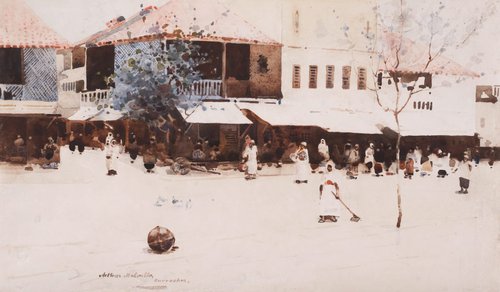Arthur Melville
Scotland
Born: Loanhead of Guthrie, Angus, Scotland 10 Apr 1855
Died: Witley, Surrey, England 28 Aug 1904
Biography
Although he also worked in oils, Arthur Melville is acclaimed primarily for his distinctive and unorthodox watercolours, which combine precise control with looseness and felicitous chance effects. His stylistic innovations, dubbed ‘blottesque’ by art critics, were consolidated in the early 1880s, by which time watercolour had become his principal medium.
The admirable finesse of Melville’s style was elucidated by Martin Hardie in his classic study, Water-colour painting in Britain: ‘He worked often into a wet surface, sponging out superfluous detail, running in those warm browns and rich blues and reds which he knew so well how to blend and simplify. His colour was often dropped on the paper in rich, full spots or blobs rather than applied with any definite brush-marks. The colour floats into little pools, with the white of the ground softening each touch. He was the most exact of craftsmen; his work is not haphazard and accidental, as might be rashly thought. Those blots in his drawings, which seem meaningless, disorderly and chaotic, are actually organised with the utmost care to lead the way to the foreseen result. Often he would put a glass over his picture and try the effect of spots of different colour on the glass before applying them to the surface of his paper.’
Melville trained in Edinburgh under the genre painter James Campbell Noble and at the Royal Scottish Academy Schools. In 1878 he went to Paris and studied at the Académie Julian; he also painted rural subjects at the artist’s colony at Grezsur- Loing. When he was in his early twenties his penchant for travel and adventure led him to embark on a journey to the Middle East, which was to be the defining event of his career.
In 1881 Melville travelled to Cairo where he remained for nearly a year before following the British imperial route to Aden and Karachi (Kurrachee). He sailed into Karachi, in modern-day Pakistan, in late March 1882, where he stayed for a few days and completed at least four closely related street scenes, including the Art Gallery of NSW’s Kurrachee featuring empty foregrounds and strong contrasts of sunlight and shadow that marvellously capture – as noted in his diary – the ‘dusty hot roads, white glare, trees covered with dust’. Melville then travelled up the Persian Gulf and on to Baghdad, where he made numerous sketches, before setting off for Constantinople. He returned to Edinburgh in September with an abundant supply of watercolours that were worked up for exhibition throughout the 1880s and 1890s.
Melville moved to London in 1889, and in the following year made the first of several visits to Spain and Morocco in pursuit of the exotic subject matter and settings he craved. He also travelled to Venice. His work was now shown internationally, and in 1893 he exhibited alongside Edgar Degas and James Abbott McNeill Whistler in the opening exhibition of the Grafton Galleries in London.
Victorian watercolours, Art Gallery of New South Wales, Sydney 2017
